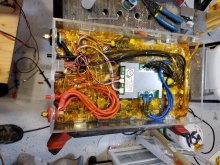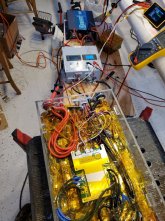Happy Holidays to all. I hope this post finds everyone healthy and safe, and to those that are suffering or have family members suffering, I send you my prayers.
I have decided to open a post in the show and tell forum in the next day or so and describe my journey, my thoughts, my successes, and my failures. It will be in several sections that I will update as I build my second battery.
I will post some pictures of my current battery later today. I am currently doing a second load/capacity test. I was trying to get a higher load on the battery to test my connections, etc and was confused as to why I could not get the higher load to hold. After some thought, some research, and feeling a little foolish, I have determined the following. I am currently feeding my 1500 watt inverter powering a ceramic heater running on low approximately 114-117 amps. The xiaoxiang app reports that this is 1436 watts. When I tried to run the heater on high, my current draw went to @145 amps before the BMS cutoff the output. The Inverter also decided that it was overloaded and it refuses this overload.
So the limiting factor on my load test is an undersized inverter for the test I was trying to perform.
I will go into my design/build thoughts a little ways here but will more fully explain my thoughts and decisions in a future post.
I am using the kWeld welder for my connections. I bought the kCap and the kSupply also. In trying to use the kSupply, I forgot/ignored that its input voltage was rated at 16 volts. When I fed it 24 volts, it smelled bad and I believe died. Not its fault. It seemed to work perfectly until I tried to force feed it too much voltage.
The kCap has worked well but I am not using it because I am using a different ultra capacitor device. I bought a Maxwell Durablue 18V 500F on Amazon. I was looking for a device that I could use for engine jump starts and of experiments. It is also rated at 18 volts so that I could experiment with higher voltages supplied to the kWeld welder.
Since I was designing a high current battery, I hoped to use some 0.3mm 8mm nickel plated copper strips in my build. I had read somewhere that the kWeld would NOT weld this copper strip. I think I have successfully proved that the kWeld will NOT weld the strips. Ass I increased the voltage supplied to the welder, I successfully blew the 300 amp fuse. I would like to report the the welder continues to work when the fuse is replaced. Being stubborn, I have gone through 5 fuses. I am now content to weld my 0.3mm 8mm and 0.2mm 8mm strips with this welder.
Finally, after I had the battery to a point of construction that I could charge and test, I did charge to 3.65 volts per cell and top balanced. I used a iCharger 8X for my charging, but did not have a very large supply, 6 amp max output, so the charging took days. When the iCharger charges, it drops the final current level to 1/10 the main charge rate for the final bit of charge. I found that if I reset the charger after the first bulk period and limited the charge rate to 1 amp, the cells topped out at 3.65 volts with a 0.0mv variation.
I am going to push off further explanations to my future post in the show and tell. Pictures to follow.





